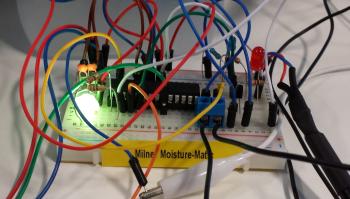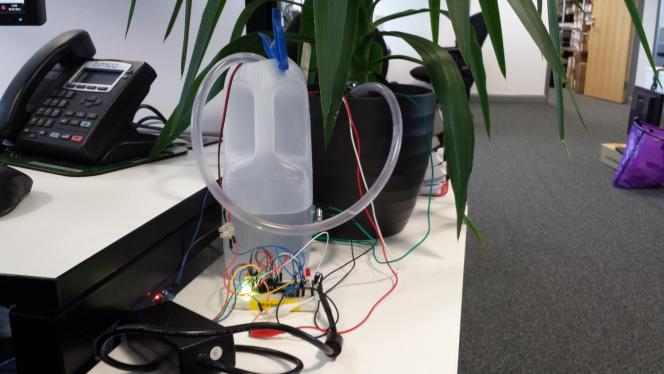Meet John Milner, crazy genius inventor. He is one of a few. A bit like Nat Morris with his Twitter based dog feeder. You’ve met John before on this blog actually should you care to look.
Today John brings you Milner’s Moisture Matic. Arduino powered with a recycled power brick the Milner Moisture Matic puts a 5V field between two bolts buried in the soil of a plant pot. The resistance is measured between the two bolts. The more moist the soil the lower the resistance. When resistance hits a threshold, ie when the current hits a certain low point, it tells the system that more water is required.
 A 10bit sensor is converted to 8bit for the processor to read. A 3 way LED tells us the state of the soil – green is good, amber is ok and red says it needs water at which point a pump kicks in for 7 seconds.
A 10bit sensor is converted to 8bit for the processor to read. A 3 way LED tells us the state of the soil – green is good, amber is ok and red says it needs water at which point a pump kicks in for 7 seconds.
Separate sensors tell us the level of water in the reservoir (reused milk jug) and whether there is water in the outside pot. The pump will only work if the moisture sensor and the pot water sensor indicate dryness.
 The Arduino processor comes with pre built twitter elements so we could extend the functionality to log reports on twitter – frequency of watering, whether the reservoir needs topping up etc.
The Arduino processor comes with pre built twitter elements so we could extend the functionality to log reports on twitter – frequency of watering, whether the reservoir needs topping up etc.
Check out the images clicking either gets you a larger image or a different view.



6 replies on “Milner’s Moisture Matic – technology made simple”
I read the subject and for a moment there I thought this was about John’s daily moisturising routine and some tips on how to keep ones face young and handsome. Guess not :p
BE.
I’m just surprised that John has a plant!
Oh and yeah brill invention 🙂
Lovely, can’t wait for all the plants in the house to be wired up!
You would have to ask yourself, Josie,whether you wanted a load of old plastic milk containers around the house 🙂
How things have changed, using a processor to do this. Am I showing my age when I say I designed the same gadget a few years ago in discreet components, a little thing called a schmitt trigger? http://en.wikipedia.org/wiki/Schmitt_trigger
🙂
Nice little project though. Is the Arduino simpler than using PIC microcontrollers?
@JV – I’ve got a couple now!
@Josie – I’ll wire one up in the greenhouse but first I’ll need to get a solar panel 🙂
@Wayne – There so cheap; you can pick up an ATmega328 IC with the Arduino boot-loader for about £3 so cheaper than the pump! The code for Arduino (Processing) is based on C so for me it was simpler to work with over PIC. Arduino also has a massive community following with some really great library’s – http://arduino.cc/en/Reference/Libraries
@Tref – I’ve order an ethernet module, we’ll have this plant tweeting in no time!